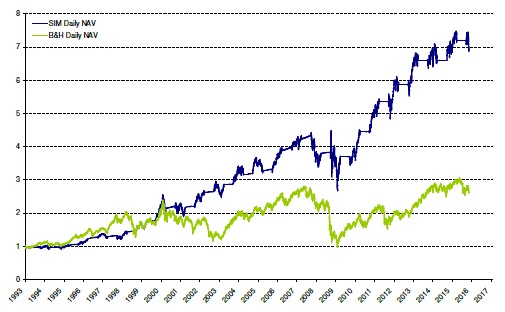Covered Calls Uncovered
A related paper has been added to:
#20 – Volatility Risk Premium Effect
Authors: Israelov, Nielsen
Title: Covered Calls Uncovered
Link: http://papers.ssrn.com/sol3/papers.cfm?abstract_id=2444999
Abstract:
Equity index covered calls have historically provided attractive risk-adjusted returns largely because they collect equity and volatility risk premia from their long equity and short volatility exposures. However, they also embed exposure to an uncompensated risk, a naïve equity market reversal strategy. This paper presents a novel performance attribution methodology, which deconstructs the strategy into these three identified exposures, in order to measure each’s contribution to the covered call’s return. The covered call’s equity exposure is responsible for most of the strategy’s risk and return. The strategy’s short volatility exposure has had a realized Sharpe ratio close to 1.0, but its contribution to risk has been less than 10 percent. The equity reversal exposure is responsible for about one-quarter of the covered call’s risk, but provides little reward. Finally, we propose a risk-managed covered call strategy that hedges the equity reversal exposure in an attempt to eliminate this uncompensated risk. Our proposed strategy improved the covered call’s Sharpe ratio, and reduced its volatility and downside equity beta.
Notable quotations from the academic research paper:
"Equity index covered calls are the most easily accessible source of the volatility risk premium to most investors. The volatility risk premium, which is absent from most investors’ portfolios, has had more than double the risk-adjusted returns (Sharpe ratio) of the equity risk premium, which is the dominant source of return for most investors. By providing the equity and volatility risk premia, equity index covered calls returns have been historically attractive, nearly matching the returns of their underlying index with significantly lower volatility.
One source of confusion on covered calls may be due to the opacity of the strategy’s risk exposures. Our paper’s first contribution is a novel performance attribution methodology for portfolios holding options, such as the covered call strategy. We demonstrate how to decompose the portfolio return into three distinct risk exposures: passive equity, equity market timing, and short volatility.
We demonstrate our proposed performance attribution by analyzing and comparing two covered call strategies. The first strategy mimics the CBOE S&P 500 BuyWrite Index (BXM), selling one-month at-the-money call options on option expiration dates. The second strategy mimics the CBOE S&P 500 2% OTM BuyWrite Index (BXY), selling one-month 2% out-of-the money call options on option expiration dates. Our performance attribution shows that passive equity is the dominant exposure for both covered call strategies. Short volatility contributes less than 10% of the risk, but with a Sharpe ratio near 1.0, adds approximately 2% annualized return to the covered call strategies.
Option-savvy market participants, such as market makers, are well aware that options include market timing, an active equity exposure. In fact, they often employ a delta-hedging program specifically designed to reduce the risk arising from this dynamic exposure. However, the covered call benchmark (CBOE BuyWrite Index) and most covered call funds do not hedge the time varying equity exposure arising from option convexity. Further, the risk and return contribution of an unhedged short option position’s dynamic equity exposure is by-and-large not reported by those who manage to those who invest in covered call strategies and is unaddressed in the covered call literature.
We employ our performance attribution to document that market timing is responsible for about one-quarter of the at-the-money covered call’s risk. The timing bet is smallest immediately after option expiration and largest just prior to option expiration. In fact, on the day before the call option expires, the equity timing position provides on average nearly the same risk as the passive equity exposure. We further show that covered call investors have not been compensated for bearing this risk. Because the embedded market timing is hedgeable by trading the underlying equity, covered call investors do not need to take that bet to earn the volatility risk premium. In other words, by shorting an option, covered calls include a market timing exposure that bets on equity reversals whose risk is material, uncompensated, and unnecessary for earning the volatility risk premium.
Having identified the covered call’s active equity exposure as an uncompensated contributor to risk, our final contribution analyzes a risk-managed covered call strategy that hedges away the identified dynamic equity exposure. On each day, the covered call’s active equity exposure may be measured by computing the delta of the strategy’s call option. The strategy trades an offsetting amount of the S&P 500 so that the covered call’s equity exposure remains constant. This risk management exercise mimics the delta-hedging approach taken by volatility desks. In so doing, the risk-managed covered call achieves higher risk-adjusted returns than does the traditional covered call because it continues to collect the same amount of equity and volatility risk premium, but is no longer exposed to equity market timing risk."
Are you looking for more strategies to read about? Check http://quantpedia.com/Screener
Do you want to see performance of trading systems we described? Check http://quantpedia.com/Chart/Performance
Do you want to know more about us? Check http://quantpedia.com/Home/About










